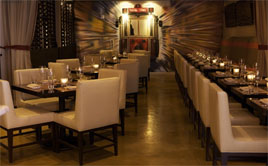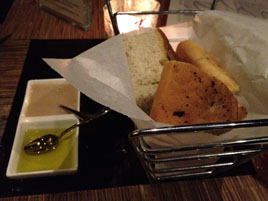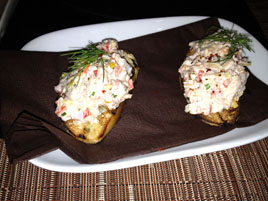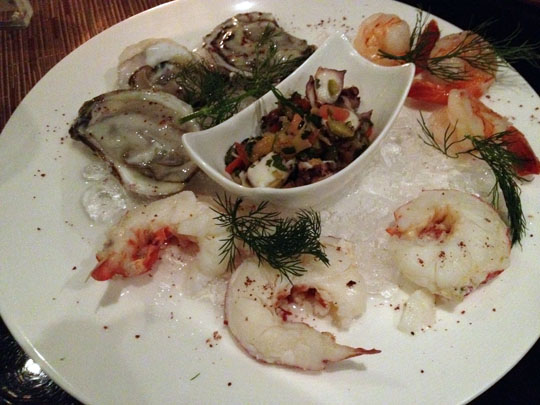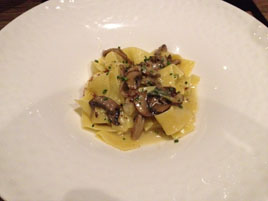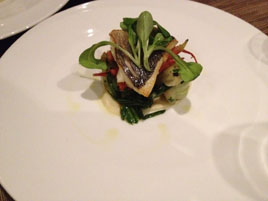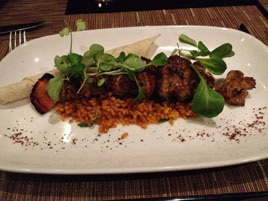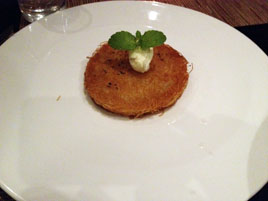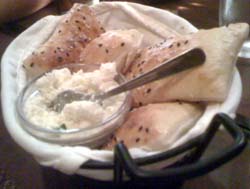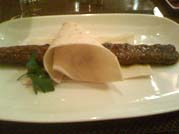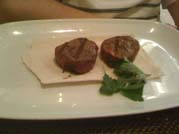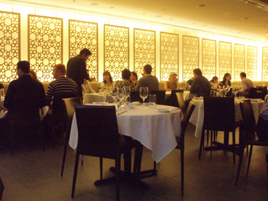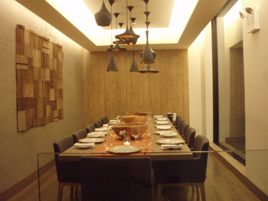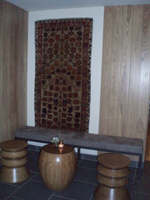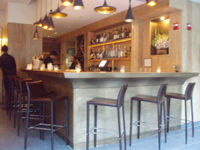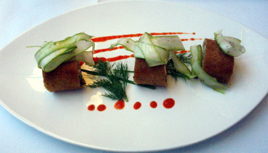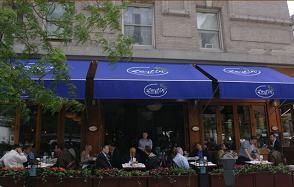Masal Café
 Saturday, March 9, 2013 at 01:31PM
Saturday, March 9, 2013 at 01:31PM 
 There probably aren’t any Turkish restaurants in New York that have quite as much history as Masal Café, which occupies a third of the legendary Lundy’s space.
There probably aren’t any Turkish restaurants in New York that have quite as much history as Masal Café, which occupies a third of the legendary Lundy’s space.
Lundy’s was a massive waterfront restaurant in Sheepshead Bay, built in the Spanish Mission-style with grand awnings and a clay-tile roof. Occupying two levels, it seated 2,400 to 2,800 guests (accounts vary). On a Mothers’s Day in the 1950s, it served 15,000 people.
My fiancée recalls that it was like Tavern on the Green, with crisp tablecloths and waiters in black tie, a place where people dressed up to go out. It probably wasn’t great—no establishment that large can be—but the former New York Times restaurant critic, Mimi Sheraton, fondly recalled the huckleberry pie and the Manhattan clam chowder.

Founded in 1934, it finally closed in 1977 after the founder, Irving Lundy, died. The building lay dormant for twenty years before Lundy’s re-opened under new ownership in 1997, at one-third the original size. The second life of Lundy’s got terrible reviews, and after floundering under multiple managements, closed for good in 2007. The remainder of the building was turned into an unsuccessful shopping mall called Lundy’s Landing.
In the meantime, the building was landmarked (so that its exterior couldn’t be altered), and zoned so that only restaurants could occupy it. The Cherry Hill Gourmet Market, a gorgeous, upscale gourmet supermarket that caters to the neighborhood’s predominantly Russian population, opened in the right-most section of the building (as viewed from the bay). You’d be elated if your neighborhood had a market like that. It got around the zoning requirement, although not without considerable controversy, by installing a “café,” though though some locals were still not satisfied.
 The rest of the building is not so lovely. The aforementioned Masal Café and Lounge occupies the central one-third, although the old Lundy’s signage is still plainly evident, and under Landmark Commission rules, cannot be removed. The left-most third is abandoned, vacant and decaying.
The rest of the building is not so lovely. The aforementioned Masal Café and Lounge occupies the central one-third, although the old Lundy’s signage is still plainly evident, and under Landmark Commission rules, cannot be removed. The left-most third is abandoned, vacant and decaying.
Masal (“fairy tale” in Turkish) got its start when owner Selahattin Karakus opened a 200 square-foot Turkish food stand in the ill-fated shopping mall. As one of the few successful businesses there, he kept acquiring space as others moved out. He now has 4,000 square feet and 40 employees.

The building sustained significant damage during Hurricane Sandy. The supermarket threw out tons of food; Masal closed for several months, during which the kitchen was re-built, the floors redone, and all the dining room furniture had to be replaced. The ceiling was left unfinished, with ductwork exposed. A few ornately-tiled columns and a handful of light fixtures are the main Turkish influences in the design. There are low-slung tables with sofas and swivel chairs. Archival photos of Lundy’s in its heyday (well worth studying) cover every wall except the back of the dining room, which displays a massive, panoramic photo of Istanbul.

The restaurant is something like a Turkish Starbucks with a diner menu. Almost everything is under $10, with a heavy emphasis on salads and breakfast. There are almost 50 desserts (mostly Italian with a few Turkish specialties). They’re open till 2 am every day (3 am weekends, and 4 am in the summer), but alcohol isn’t served. According to Mr. Karakus, there’s a steady procession of regulars during the day, families in the early evening, and overflow from the nearby clubs in the late night hours. As far as we could tell (at 7 pm on a Sunday evening), most of the guests were speaking Russian, the predominant demographic of Sheepshead Bay these days.

We visited at the owner’s invitation and did not pay for our meal. The dishes we were served were primarily the house suggestion. Prices noted below are from the online menu.

There are several entrées referred to as “flat pies” with a yogurt sauce and four choices of filling: meat, potato, spinach, or cheese, all $6. The Meat Pie (above) was remarkably good, resembling a savory crèpe, with a very thin dough and spiced beef inside.


We had to try the Shepherd Salad ($8 or $12; above left), with tomatoes, green peppers, cucumbers, onions, dill, parsley, and a heavy dose of shredded feta cheese. Despite the memorable name, it struck us as an ordinary salad.
The Turkish-style Ravioli ($15; above right) are made with a light dough, almost like gnocchi, and stuffed with lamb. It wasn’t served quite warm enough, and we felt the pasta was overwhelmed with too much cream.
The only other entrée is the stuffed baked potato ($7.50; $1 extra for sausage or feta cheese), which we didn’t try, but appeared to be the most popular dish, as we saw one on almost every table.


The kitchen next sent out a cheese and vegetable platter (which I don’t see on the menu), but what we liked best was the fresh bread, which resembled a focaccia.


Of the desserts, our favorite was the oven-baked pudding ($5; above left), a light confection of sugar and egg. A mixed platter of Italian sweets (above right) was a mixed bag: a few were good, while several others were too syrupy for our taste.
Masal Café doesn’t serve destination cuisine, but it offered a fascinating snapshot of a neighborhood in transition. There are brightly-lit Soviet-style nightclubs down the street and the mansions of Manhattan Beach just across the bay. No restaurant resembling the old Lundy’s could work there today. But if only the remaining one-third of the old Lundy’s space could be brought back to life in another guise, the building could be the centerpiece of the neighborhood, as it once was.
Masal Café (1901 Emmons Ave. at Ocean Ave., Sheepshead Bay, Brooklyn)
 Masal Caf in
Masal Caf in  Brooklyn,
Brooklyn,  Cuisines: Turkish,
Cuisines: Turkish,  Restaurant Reviews
Restaurant Reviews 


